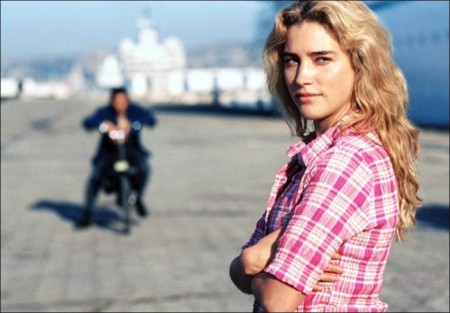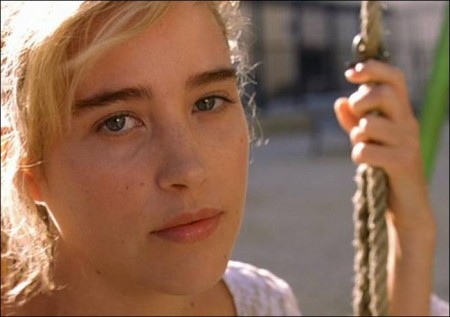The story explores an Arabic 19 year old aspiring writer named Chimo who falls for Lila, the sexually forthright and stunning French girl who moves into the Parisian ghetto he grew up in. With her torrid glances and explicit fantasies, Lila engages Chimo in a game of sexual discovery that walks a fine line between innocence and danger.
With the striking performance of newcomer Vahina Giocante as the promiscuous young girl, LILA SAYS is an unbelievably sexy and unexpectedly shocking film, showing a side of innocence and sexuality rarely depicted on the screen.
Il n’a encore jamais parlé de « ça », comme ça, avec personne.
Elle n’a encore jamais trouvé personne à qui parler.
Elle ne pense qu’à ce garçon-là, il faut lui parler de ça pour s’en faire aimer.
Elle a 16 ans et lui 19.
He has never talked to anyone about “it”.
She has never found anyone she wants to talk about “it” with.
All she thinks about is him; and that she must talk about “it” with him if she wants his love.
She’s 16; he’s 19.
About the Film
Lila Dit Ca”Lila Says” is based on a book that caused much controversy in France. Nineteen-year-old quiet poet Chimo (Mohammed Khouas) falls for Lila (Vahina Giacante), a gorgeous, blonde girl who just moved in with her creepy aunt in an Arab ghetto. One day Lila asks Chimo to look up her skirt — if he can handle it. Meanwhile, Mouloud (Karim Benhadou), the loud leader of a rival gang, also sets his sights on Lila. Their game of sexual discovery leads to an unexpected look at tolerance, self-hatred, and machismo. It also questions the fantasy that permeates the film with fun and danger.
Set in Marseilles, this coming-of-age tale centers on a Lolita-esque teen who is a big tease to a shy Arab kid. Lila is a gorgeous 16-year-old girl who has just moved, with her rather strange aunt, into a poor neighborhood populated primarily by Arab families. The two leaders of the suburb’s main gang fall in love with her. One is the film’s poetic narrator, a quiet boy with a talent for writing named Chimo; the other is Mouloud, a headstrong punk. One day, Lila dares Chimo to look up her skirt — if he can handle it — and by doing so, puts into motion a sequence of raw, devastating events. The ensuing maelstrom that develops out of this romantic triangle reveals the dangers inherent in sexual game playing.
Interview with Ziad Doueiri
– “Lila Says” is a novel that has entered into the annals of erotic literature. How did you approach the story?
For me “Lila Says” is above all a love story between a certain person, Lila, who shows up in the life of another, Chimo. She tells him such highly provocative, raw, and racy stories that he can’t help himself from entering her universe. Chimo embarks on a voyage where he doesn’t know the route. Without knowing it, Lila provokes a change in Chimo. She leads him to change his life. It’s a passionate love story but without a classic declaration of love.
– What problems were there with the adaptation of the novel?
First of all the story didn’t have a conventional structure. The book is written in the first person. It’s Chimo that tells his story. The problem with the voice-over is that the narration becomes monotone. We had to find the right dose. The other problem concerned Chimo’s character, because in the book he is very passive. We had to construct a character accomplishing a more cinematographic journey.
It was all the more difficult because the book was so well written. Chimo is very touching but he’s slow. He talks very little while everything goes on in his head. The other problem is that there wasn’t an antagonist. Meaning that aside from Lila and Chimo, the secondary characters hardly existed. I had to more clearly define the obstacles to their relationship.
– Why did you decide to transpose the story of the Parisian outskirts / suburbs to Marseille?
When the book came out in 1996 is was pretty innovative. We had just started to talk about the suburbs in film. I quickly realized that the Parisian suburbs, with their code and psychology, were totally foreign to me. I preferred going to shoot in a Mediterranean region closer to my roots. I left for Marseille looking for small narrow roads, houses one on top of the other, and wash hanging out to dry. It was also an esthetic choice.
– How would you describe your heroes?
They are heroes from a modern tale. Chimo is an adolescent dreamer, a solitary person who speaks very little and escapes in his “visions.” His imaginary world brings a poetic dimension to a background more sober and with a more cynical view on reality. He is a bit overwhelmed by Lila who has a very insolent way of loving and who expresses herself freely about sex. She’s only 16 but she’s not a sentimental, naïve little girl. She’s raw and ambiguous, but sincere.
– Her language at times is close to pornographic.
We’re on a thin line here. Lila speaks about love in an erotic, “different” and romantic way but never vulgar. Another actress, other than Vahina, could have recited the same lines and it would have been ridiculous, corny, or even ordinary.
– How did you work with Vahina Giocante and Mohammed Khouas?
I can’t say that my work with them was methodical or systematic. I started off by showing them three key films so they could understand my vision and what I was looking for in their acting: Rusty James by Francis Ford Coppola for the lightness and carefree nature of the characters; Leolo by Jean-Claude Lauzon, a very lyrical film with a voice-over from the beginning to end and music throughout; and The Cement Garden by Andrew Birkin which is a sensual and strange film. In watching these films together, we placed the first brick that allowed them to construct their characters little by little in an organic fashion.
– How did you approach the most sensual scenes with Vahina Giocante?
I never felt any reluctance. She was very open. Five minutes after our first meeting she told me that she was ready to go all out for this film. And the way she told me “we’re on this trip together” signified in the simplest way in the world, that she accepted the risk.
– How did you shoot the erotic scene on the moped?
It was the scene that required the most preparation. In the book it was a bicycle, but with two of them it was dangerous. It was difficult for Mohammed who had to pedal, say his lines and act out the scene. I found that the moped had something magical with its cylinder motor mounted on the front wheel. The only problem was that the moped was small for two to be on it at the same time so we lengthened the chassis 25 centimeters. We also lengthened the seat so they could both sit on it and raised the handlebars to transform the moped into a hybrid machine in the image of a Harley Davidson.
I wanted the scene to be shot entirely with movement. We didn’t want a static camera or any sequenced shots. We had to go through the right area with the sun in order to create shadows. We really tired out the steady cam operator who approached, moved out and zigzagged around them to create this liberty. In post, I added the music from “Air” that plays enormously well on the atmosphere of the scene.
– The story evokes the difficult times of adolescent life and the difficulty in approaching sexual relations.
Finding someone to talk to and emerging from one’s solitude are preoccupations that go along with adolescence, but also with modern society on a whole. As for sex, it’s approached with rawness and spontaneity that characterizes an adolescent who lacks bearings. Adolescence lost in its French and Arab sense of belonging. Adolescence tossed about in the folds of identity.
– The film also touches on community and religious conflicts…
It’s a very familiar theme for me since I grew up in Lebanon where 17 religious communities lived together. The film takes into consideration the events of September 11th to evoke the fear of difference, racism and integration. But the ideas are handled by the young who have a spontaneity representing their age. Moulod, the head of the group of Chimo’s friends, is proud to be Arab, but uncomfortable being out of his ghetto. He is a person that does not change, while Chimo goes and opens up and gains liberty.
– Your choices for music are also very well calculated.
The ambiance is very important and I deliberately avoided the clichéd use of rap music in order to go after Anglo-Saxon groups. I wrote numerous scenes while getting inspiration from Vanessa Dauo whose songs talk of seduction, provocation, and sexuality. Certain lyrics are written by Erica Jong, author of “Fear of Flying”, and they invoke the strange meeting between Chimo and Lila. I would love for the viewer to be whisked away on a magical voyage of two adolescents who only want to love and be loved.
– Why did you radically change the ending of the book?
The ending was too dramatic. I wanted to make it more bittersweet and stay on a positive note of hope.
– What was the challenge in interpreting Lila?
It was difficult interpreting a young girl in love whose behavior is sensual and even erotic to the point of being shocking because she doesn’t know any other way of communicating. Lila invents her own life with the nature of a child who spouts off words without knowing their meaning.
Her innocence brings about things that could be destabilizing and troubling. She accepts her image of Lolita, as an “easy” girl…but it’s no big deal. She doesn’t have this kind of judgment. She knows she’s not a whore, she knows who she is. She could be considered “easy” if she flirted with all the guys…but she only flirts with Chimo. She fixes her attention on him because she finds him to be different and because there is poetry in him. She simply says to him “I like your eyes when I talk to you.”
– How did you get into the skin of Lila’s character?
Lila is 16 and the big question was to know if I would be able to play a young girl, to go back to a freshness and naivety of adolescence. Physically we worked on the blond angelic side of my appearance. Once I was in character my voice, gait, and mannerisms fell easily into place.
– When Lila talks about “that” with those raw words, is she in fact talking about love?
Of course. She’s a player. She experiments without any unhealthy thoughts behind it. But behind these shocking phrases she’s saying fundamental things about love. She lures Chimo, she probes him, and she tries to figure out what he thinks through her provocations. She has double meaning in her language.
One shouldn’t stop at the façade she presents. One should look deep into her eyes. They tell the truth. The actor’s work is being able to say something while thinking the opposite. It’s arriving at decoding this double language between what Lila says and what Lila means.
– Is there a scene that was difficult for you?
Not a scene, a phrase. The most difficult one in the entire movie was “Fuck, Chimo, don’t you see I love you.” It’s the key that opens the door. Suddenly Lila shows herself like she never has before. It’s the only scene where she’s completely “naked”. Even when you see her butt, or when she says some pretty daring things, it’s at this moment that she’s vulnerable. The phrase “I love you” is totally charged with meaning… it’s something I have a difficult time saying and hardly do in real life.
– How did Ziad guide you?
I’m totally instinctive. In a given setting I show what I feel. For me, an actor is a vehicle and the director is the driver. The vehicle can be more or less reactive and sensitive but it’s up to the driver to steer the vehicle where he wants. He chooses the direction, the road, the detours taken, and the type of terrain. With Ziad we really didn’t need to talk. There was a total osmosis. We clicked from the very first minutes of our first meeting. I saw Lila as ethereal and elusive. The character just evolved on its own.
– Ziad creates a very distinct universe of sound. Did he use it during the filming?
During the scenes he blasted music. Because I’m an ex-dancer I’m very sensitive to it. I have a very natural relationship with moving my body. With the music blaring, all the cells of my body moved.
– You seemed really at ease in front of the camera, even when the scenes were really provocative?
I have a love relationship with the camera. The closer it gets the more I have the impression it’s a lover. When I move around the camera I feel like I’m dancing with it. The camera feeds me…inspires me…gives me wings. I live it all to the max until I hear the word “Cut!” I do what I have to do in the scene…I’m in another world.
– How do you plan on talking about Lila to adolescents who go to see the film?
I bring together all of Lila’s claims…her way of expressing her liberty, her femininity, and her sexuality. I demand the right to have fantasies, express them, and enjoy the pleasure. But today, even if consciousnesses have evolved, I think there’s still a lot of work to be done as far as culpability is concerned. The strong thing about Lila is her liberty, and the fact that she never judges herself. She lives her life and wholly accepts it no matter if it’s badly perceived and interpreted.
Finally, she’s a victim, because the world is not ready to be carefree like her. Lila is an angel who has landed in these suburbs to awaken Chimo’s conscience. She’s the muse that inspires Chimo’s book. She has within herself such a great resource of dreams, imagination, and fantasy, and can bring others along into her imaginary world. Even after all she has gone through she remains strong. She never doubted Chimo. When he tells her “I love you” she responds “I know.”
– Watching LILA SAYS one thinks of Bridget Bardot in AND GOD CREATED WOMAN. First, because you look like her, and second, because the film ignites female liberation.
During her time, Bardot helped evolve the spirit of the period. She accepted her liberty and her sensuality. I think Lila is also a marvelous model for female liberty. In addition, I didn’t, at any moment have the feeling of going too far in the role. For me, Lila is touching and keeps her integrity.
– Do you think that this film could better help adolescents approach sexual relations?
For adolescents who haven’t had sexual relations yet, sex is seen as something very worrisome. They don’t know where to situate themselves between the pornography they see on television, the psychological and abstract feelings they discover in movies, and their reality, which is often more prudish and codified. Between the purely physical, emotionally bare side of sex, and the very romantic side, which is heavy with consequences, adolescents cannot possibly project how it really is. This film presents sensuality with very explicit and explanatory words but also with a certain lightness, poetry, and humor…not at all guilt driven or violent except for the end which says: How far can the ignorance, frustration, and incomprehension of a woman and her pleasure be taken?
– How would you classify this role in your career?
It’s a role that kind of imposed itself naturally. Very fluid and simple. I really melted into the character of Lila so much that I didn’t experience any obstacles. Maybe it’s because I’m at a magical period in my life where I still feel really close to my adolescence while still experiencing love and the sexual side of being a woman. I can bounce back and forth between the two. I feel very much complete as a person.
I’m strong, animalistic, a hunter, and a little lost bird all in one. I’m like Lila actually. I love new experiences and to see how far I can go. I’m not afraid to fall because I’m resilient and I know how to get back up. I’m not afraid to suffer because I’m willing to accept and forgive. Therefore I don’t see what can stop me from going wherever I want as an actress.
These production notes provided by Samuel Goldwyn Films.
Lila Says
Starring: Vahina Giocante, Mohammed Khouas, Karim Ben Haddou, Lotfi Chakri, Hamid Dkhissi, Carmen Lebbos, Stéphanie Fatout, Barbara Chossis
Directed by: Ziad Doueiri
Screenplay by: Ziad Doueiri, Mark Lawrence, Joelle Touma
Release Date: July 1th, 2005
MPAA Rating: Not Rated.
Studio: Samuel Goldwyn Films
Box Office Totals
Domestic: $121,365 (22.6%)
Foreign: $416,506 (77.4%)
Total: $537,871 (Worldwide)





